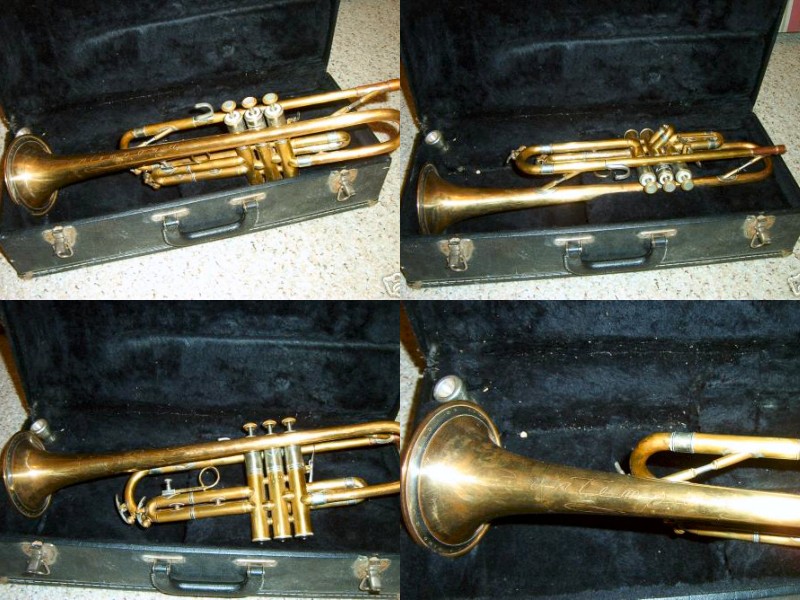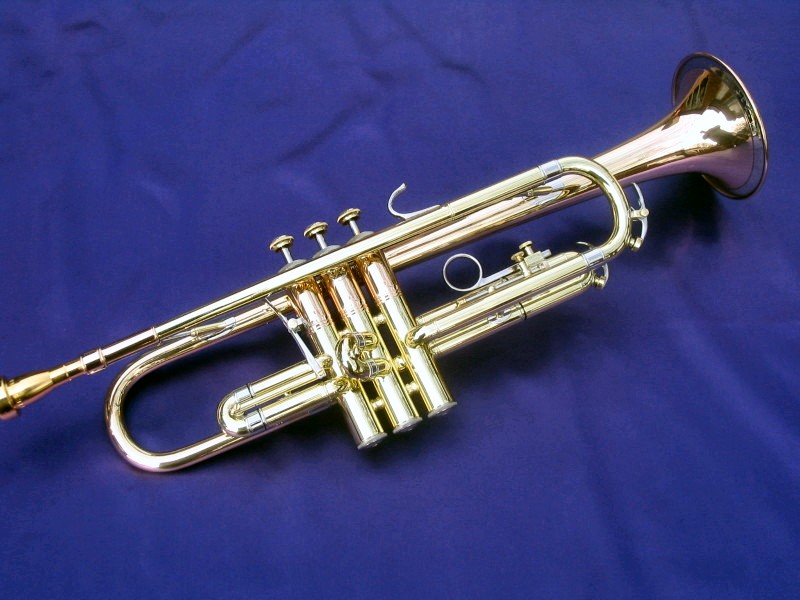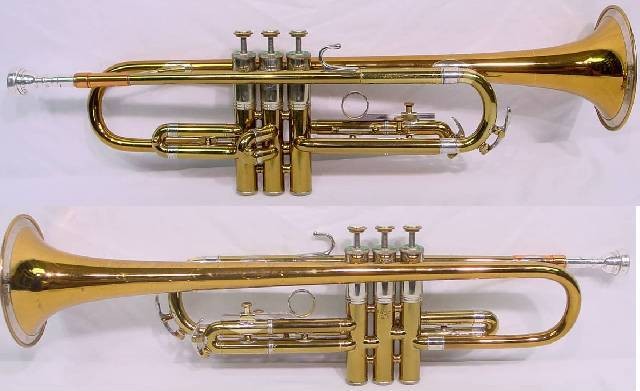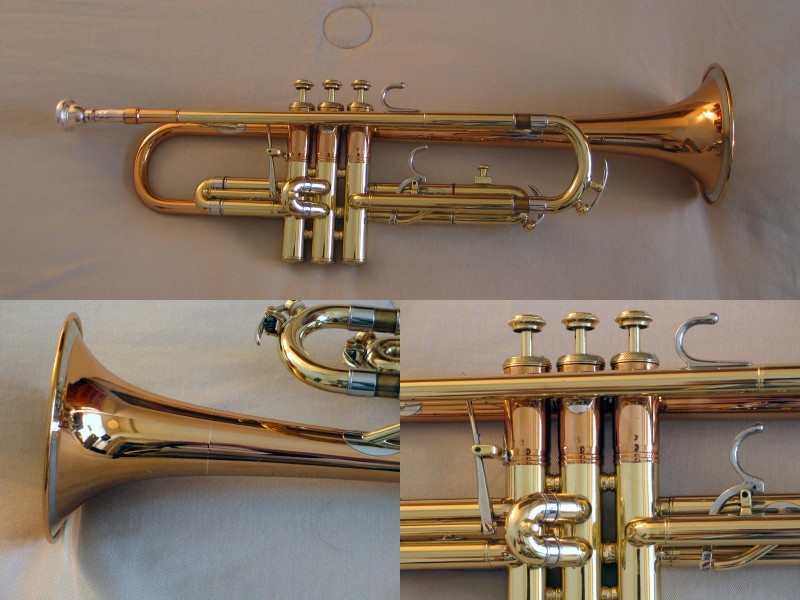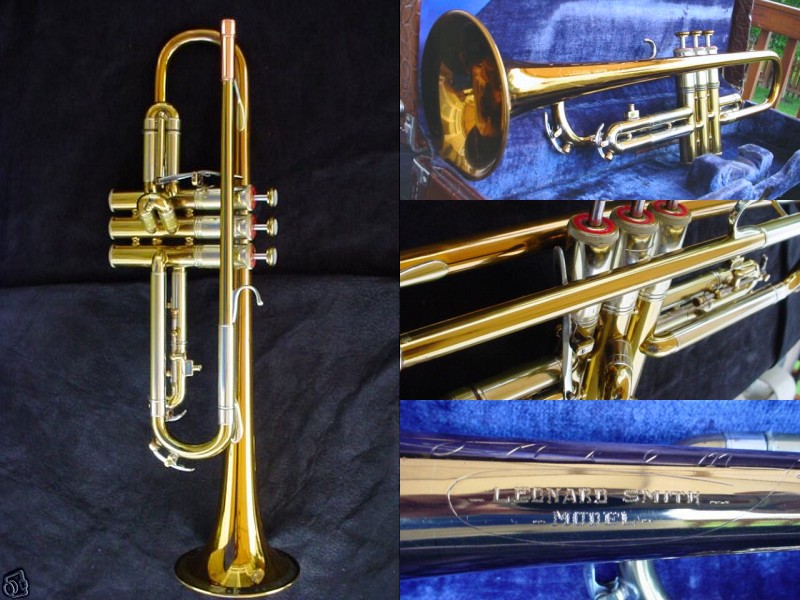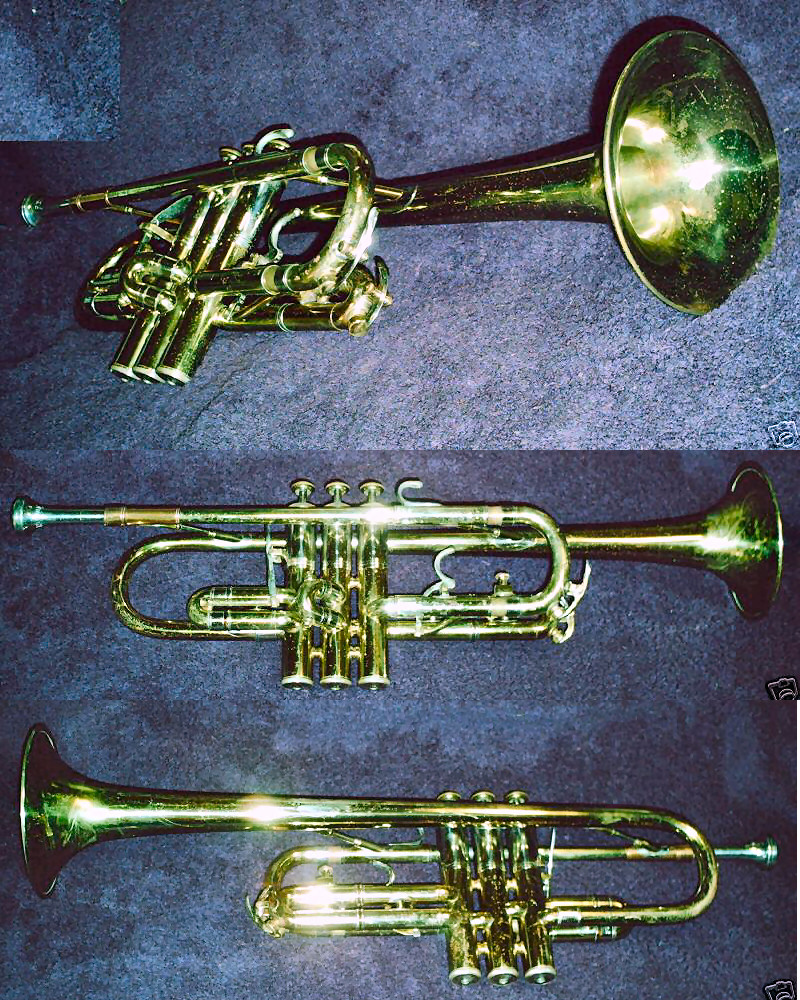
Introduced in 1949, the Contempora trumpet was Reynolds' flagship model until the company ceased operations in 1979. The Contempora inherited the basic design of Reynolds' original models and added new features like a bronze-alloy bell with nickel-silver tone ring, monel steel valve pistons, an optional first-valve slide "trigger" tuning mechanism and a larger bore size. Models in C tuning were also offered.
There is an undeniable similarity in appearance to the older Olds Super trumpet with its bronze bell and tone ring. By 1948, Foster A. Reynolds had left his company and moved to Los Angeles to build a new plant for Olds. Whether the similar designs of the Contempora were coincidence, collaboration or competition is unknown.
1946-1952
F.A. Reynolds, division of Scherl & Roth (Cleveland, Ohio)
According to the trademark application filed with the U.S. Patent Office, the name “Contempora” and original stylized script were first used on May 5, 1949 and designated for “cornets, trumpets, trombones, altos, baritones, basses, french horns, clarinets, oboes, piccolos, flutes, bassoons [and] euphoniums.”
Models made in this early timeframe have two bell engravings: the distinctive Contempora script lengthwise down the bell, and a heavier block-letter "Reynolds" inscription across the bell flare.
Model 40
Large-bore B♭ trumpet with first-valve trigger
Bore: .464" large bore (.458" medium large bore also available)
Bell: 4-5/8", bronze alloy with nickel-silver tone ring
Length: 21½"
Materials: brass body with nickel-silver upper valve casings (balusters) and trim
Valves: top-loaded, inner-spring Monel valve pistons
Finish: Brass with durable clear lacquer finish
Contempora Trumpet, Model 40
SN 28584, c.1952. Photo source: eBay.
Model 41
Same as Model 40 without first-valve trigger.
Trumpets have come and trumpets have gone, but every professional and amateur who has played this new Reynolds Large Bore Contempora says it is the last word in graceful appearance, responsiveness, big smooth tone, and sure, flawless performance. Has a new feature: trigger for the important first valve slide.
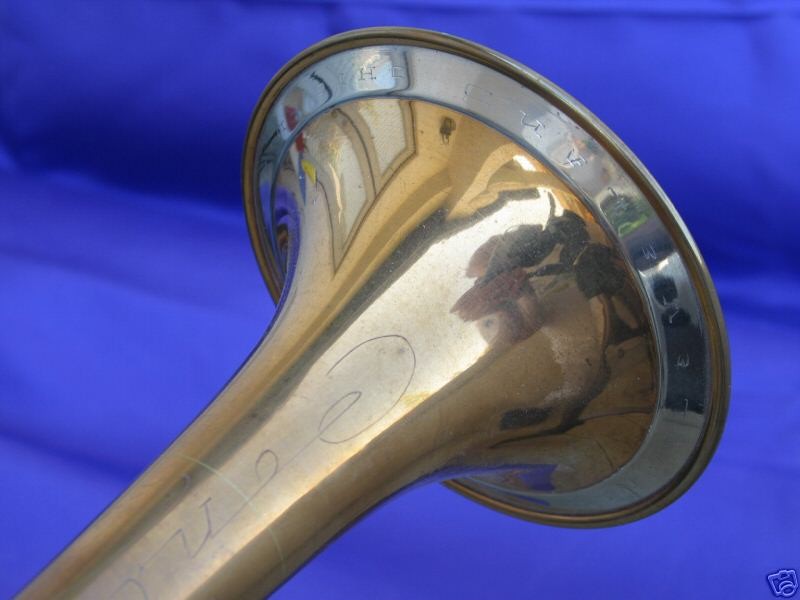
The "Kranz"
Contempora trumpets, cornets and tenor trombones introduced a new feature to the Reynolds catalog: the bell tone ring, or Kranz. Made of nickel silver, tone rings were traditionally added to instruments with thin bell flares to help dampen the vibration of the bell and keep the sound from breaking up too early at higher volumes. The best-known American band instruments with tone rings were the Olds Super line, introduced in 1932.
Whether the Contempora tone ring was added to balance a thinner bronze alloy bell or as a marketing "feature" to compete with Olds (now led by Foster Reynolds) is unknown. The fact that the tone ring does not appear on the Contempora bass trombone or other Contempora models suggests at least both options.
1952-1961
Roth-Reynolds (Cleveland, Ohio)
As F.A. Reynolds became Roth-Reynolds, the Contempora trumpet was offered in numerous variations, each with a specific model number. Large or medium bores, with or without the first-valve slide trigger, models in B♭ or C, and special tuning mechanisms expanded the product catalog dramatically over the 1950s.
By 1956, band leader Leonard Smith had become the marketing face of the Contempora trumpet and cornet line, much as James Chambers would do for the double horn and other professional artists promoted various instruments for Reynolds. Reynolds created a "Leonard Smith" model Contempora trumpet (40-S) that added nickel-silver slide tubes to the Model 40-L, special engraving and a double carry case with the matched cornet model.
Model 40-L
Large-bore B♭ trumpet with first-valve trigger
Bore: .462"
Bell: 4-5/8", bronze alloy with nickel-silver tone ring
Length: 21½"
Materials: brass body with nickel-silver upper valve casings (balusters) and trim; bronze-alloy mouthpiece receiver
Valves: top-loaded, inner-spring Monel valve pistons
Finish: clear lacquer finish; optional silverplate with bright bell or gold bell finish
Options: third-valve slide trigger was available for additional charge
Contempora Trumpet, Model 40-L
SN 45394, c.1957. Photo source: eBay.
Model 40-M
Same as Model 40-L with medium .458" bore.
Contempora Trumpet, Model 40-M
SN 33172, c.1953. Photos used with permission from Jack Laperriere (trumpetherald: The Royal Lancer).
Model 41-L
Large-bore B♭ trumpet—no first-valve trigger
Bore: .462"
Bell: 4-5/8", bronze alloy with nickel-silver tone ring
Length: 21½"
Materials: brass body with nickel-silver upper valve casings (balusters) and trim; bronze-alloy mouthpiece receiver
Valves: top-loaded, inner-spring Monel valve pistons
Finish: clear lacquer finish; optional silverplate with bright bell or gold bell finish
Options: third-valve slide trigger was available for additional charge
Contempora Trumpet, Model 41-L
Photo source: eBay.
Model 41-M
Same as Model 41-L with medium .458" bore.
Contempora Trumpet, Model 41-M
SN 52114, c.1958. Photos used with permission from Don Rugg.
Historical Note
Contempora trumpets and cornets with serial numbers in the 32xxx-36xxx range (c.1953-54) have upper valve casings made of what appears to be the same bronze alloy as the bell and mouthpiece receiver.
Contempora Trumpet, Model 40-L
SN 33231, c.1953. Photos used with permission from David Jordan (eBay Member: ddjordan5039).
The Reynolds Contempora Trumpet embodies the ultimate in fine playing qualities demanded by today’s artists. Beautifully designed from mouthpipe to its graceful Bronz-o-lyte Bell, it features monel steel valves for a lifetime of accurate performance. Every detail of this instrument is so carefully crafted that the Contempora is truly the pride of Roth-Reynolds. Each instrument is tested by outstanding symphony musicians before it leaves our factory.
Model 40-S
"Leonard Smith" B♭ trumpet with first-valve trigger
Bore: .462"
Bell: 4-5/8", bronze alloy with nickel-silver tone ring
Length: 21½"
Materials: brass body with nickel-silver slide tubes, upper valve casings (balusters) and trim
Valves: top-loaded, inner-spring Monel valve pistons
Finish: clear lacquer finish; optional triple gold-plate finish
Options: third-valve slide trigger was available for additional charge
Note: introduced in the mid-1950s (appears in 1958 catalog, but not the 1953 catalog)
Contempora Trumpet, Model 40-S
SN 46741, c.1957. Photos used with permission from David Greenfield (eBay: gree44332).
Brilliant tone amplified by the Bronz-o-lyte bell. Contempora trumpets are masterpieces of perfection. The first trumpet with perfected Monel valves achieved after many years of research and engineering. Excellent balance. Available with or without first valve trigger for delicate intonation adjustments. Each Contempora trumpet is rigidly tested by members of the Cleveland Symphony Orchestra to insure perfection throughout. Possesses sparkling tone that makes the instrument literally come alive in your hands!
Model 43-L
Large-bore trumpet in C with first-valve trigger
Bore: .462"
Bell: 4-5/8", bronze alloy with nickel-silver tone ring
Length: 21½"
Materials: brass body with nickel-silver upper valve casings (balusters) and trim; bronze-alloy mouthpiece receiver
Valves: top-loaded, inner-spring Monel valve pistons
Finish: clear lacquer finish; optional silverplate with bright bell or gold bell finish
Options: third-valve slide trigger was available for additional charge
Note: introduced in the mid-1950s (appears in 1958 catalog, but not the 1953 catalog)
Contempora Trumpet, Model 43-L
SN 51074, c.1958. Photos used with permission from Santos Rivera, Jr. (West Texas A&M University).
Model 43-M
Same as Model 43-L with medium .458" bore. Example shown with optional third-valve slide trigger.
Contempora Trumpet, Model 43-M
SN 50954, c.1958. Photo source: eBay.
"Diatonic" Models
Contempora trumpets and cornets with “Diatonic” compensating tuning mechanisms were available in the early 1950s, if not earlier. Unlike the standard Contempora models, which had a trigger mechanism connected to the first-valve slide, the Diatonic model (42-L) with the “Tune-As-You-Play” (TAYP) mechanism featured a trigger connected to the main tuning slide that allowed any note to be adjusted as the instrument was played.
Trumpet in C models (44-L/M) were added in 1958. The “Contempora Diatonic” trumpets were rebranded as “Renascence” models in the 1959 catalog and went out of production sometime after Reynolds was sold to RMC (1961).
A truly sensational trumpet with ‘tune-as-you-play’ mechanism. Its amazing tuning features, superb tonal qualities and unlimited flexibility have made the ‘Renascence’ trumpet in a comparatively short period of time the choice of the country’s most discriminating musicians.
Model 42-L
Large-bore "Renascence" B♭ trumpet with “Tune-As-You-Play” mechanism instead of first-valve trigger
Bore: .462"
Bell: 4-5/8", bronze alloy with nickel-silver tone ring
Length: 21½"
Materials: brass body with nickel-silver upper valve casings (balusters) and trim
Valves: top-loaded, inner-spring Monel valve pistons
Finish: clear lacquer finish; optional silverplate with bright bell or gold bell finish
Contempora Trumpet, Model 42-L
SN 57xxx, c.1960. Photo source: eBay.
Model 44-L
Large-bore "Renascence" trumpet in C with “Tune-As-You-Play” mechanism instead of first-valve trigger
Bore: .462"
Bell: 4-5/8", bronze alloy with nickel-silver tone ring
Length: 21½"
Materials: brass body with nickel-silver upper valve casings (balusters) and trim
Valves: top-loaded, inner-spring Monel valve pistons
Finish: clear lacquer finish; optional silverplate with bright bell or gold bell finish
Model 44-M
Same as Model 44-L with medium .458" bore
1961-1964
RMC-Reynolds (Cleveland, Ohio)
Sometime after Richards Music purchased Reynolds in 1961, the product catalog was streamlined and many model variations were eliminated. Old model numbers were replaced with new ones that reflected the type of instrument. To the best of knowledge, the remaining instrument specifications did not change, just the model numbers.
Model TU-11
Large-bore B♭ trumpet with first-valve trigger (previously Model 40-L)
Bore: .462"
Bell: 4-5/8", bronze alloy with nickel-silver tone ring
Length: 21½"
Materials: brass body with nickel-silver slide tubes, upper valve casings (balusters) and trim
Valves: top-loaded, inner-spring Monel valve pistons
Finish: clear lacquer finish; optional silverplate with bright bell or gold bell finish
Contempora Trumpet, Model TU-11
SN 74079, c.1963. Photos courtesy of eBay seller: wideangleman.
Model TU-13
Large-bore trumpet in C with first-valve trigger (previously Model 43-L)
Bore: .462"
Bell: 4-5/8", bronze alloy with nickel-silver tone ring
Length: 21½"
Materials: brass body with nickel-silver slide tubes, upper valve casings (balusters) and trim
Valves: top-loaded, inner-spring Monel valve pistons
Finish: clear lacquer finish; optional silverplate with bright bell or gold bell finish
Model TU-15
Large-bore B♭ trumpet—no first-valve trigger (previously Model 41-L)
Bore: .462"
Bell: 4-5/8", bronze alloy with nickel-silver tone ring
Length: 21½"
Materials: brass body with nickel-silver slide tubes, upper valve casings (balusters) and trim
Valves: top-loaded, inner-spring Monel valve pistons
Finish: clear lacquer finish; optional silverplate with bright bell or gold bell finish
Designed with a bore that meets the exacting requirements of world-reknown artists, this instrument will give every performer complete freedom of interpretation and control. Each instrument produces its traditional tonal color -- brilliance in the trumpet and mellowness in the cornet -- with exceptional projection and carrying power in all dynamic levels. Solid monel-nickel valve pistons for perfect action over a longer period of use. Bronze-alloy bell. Optional first valve trigger.
1964-1970
Reynolds (Abilene, Texas)
When Reynolds moved operations to Abilene, Texas, there were slight adjustments to the instrument specifications and further consolidation of the product line.
Choice of professionals for exceptional projection and carrying power in all dynamic levels. Easy-action solid monel-nickel valve pistons for longer wear. Nickel-silver slides, trim and tone ring; bronze alloy bell. First-valve trigger for more precise control over intonation.
Model TU-11
Large-bore B♭ trumpet with first-valve trigger
Bore: .468"
Bell: 4-3/4", bronze alloy with nickel-silver tone ring
Materials: brass body with nickel-silver slide tubes, upper valve casings (balusters) and trim
Valves: top-loaded, inner-spring valve pistons
Finish: polished brass finish with epoxy coating
Contempora Trumpet, Model TU-11
SN 246821, c.1969. Photo source: eBay.
Model TU-13
Large-bore trumpet in C with first-valve trigger
Bore: .468"
Bell: 4-3/4", bronze alloy with nickel-silver tone ring
Materials: brass body with nickel-silver slide tubes, upper valve casings (balusters) and trim
Valves: top-loaded, inner-spring valve pistons
Finish: polished brass finish with epoxy coating
1970-1979
Reynolds (Fullerton, Calif.)
Reynolds closed the Abilene plant in 1970 and fully merged production lines with Olds in Fullerton. In the process, there were additional adjustments to the Contempora trumpet specifications. Most notably, the change of bell materials to red brass (Lubaloy) from the distinctive bronze alloy that had marked Contempora trumpets since their introduction to the Reynolds catalog.
Model TU-10
Large-bore B♭ trumpet with first-valve trigger
Bore: .464"
Bell: 5", red brass
Materials: brass body with nickel-silver slide tubes, upper valve casings (balusters) and trim
Valves: top-loaded, inner-spring valve pistons
Finish: polished brass finish with epoxy coating
Contempora Trumpet, Model TU-10
SN 282192, c.1973. Photo(s) used with permission from Don Rugg of Relic Rescue (eBay Member: relic_rescue).
A large bore instrument with a dynamic sound designed for professional work. Quality craftsmanship and precision engineering provide exceptional intonation and powerful projection. Fast-action valve pistons insure a quick and immediate response. 3rd valve slide throw and 1st valve trigger.
Model TU-13
Medium-large bore trumpet in C with first-valve trigger
Bore: .460"
Bell: 4-3/4", red brass
Materials: brass body, valve casings and leadpipe with nickel-silver slides and trim
Valves: top-loaded, inner-spring valve pistons
Finish: polished brass finish with epoxy coating
Note: Model TU-13 was absent from the Reynolds catalog from 1969 or 1970 until late 1974.
Contempora Trumpet, Model TU-13
SN 288814, c.1974. Photos used with permission from Washington Music Center (eBay Member: chucklevins).
The purpose of this website is to preserve the history of the F. A. Reynolds Company and the distinctive qualities of its brass instruments. Contempora Corner and contemporacorner.com are not related or associated in any way to the former or current F.A. Reynolds Company.
Copyright © 2004-2024 ElShaddai Edwards. All Rights Reserved. Terms of Use.


